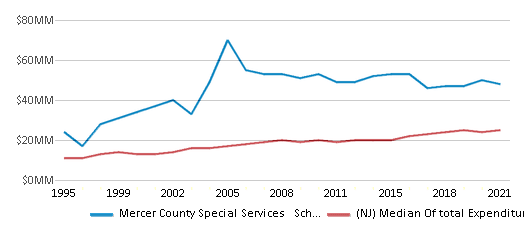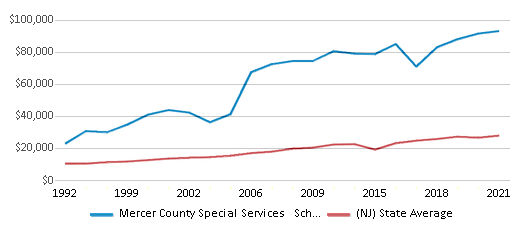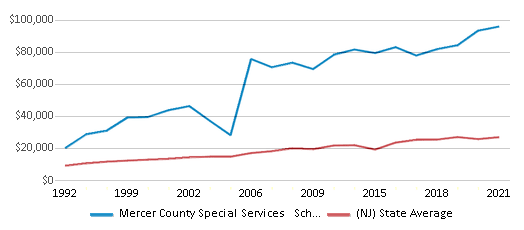Top Rankings
Mercer County Special Services School District ranks among the top 20% of public school district in New Jersey for:
Category
Attribute
Science Proficiency
Highest science proficiency (Top 10%)
Diversity
Most diverse schools (Top 1%)
Student Attention
Lowest student:teacher ratio (Top 1%)
For the 2025 school year, there are 2 public high schools serving 185 students in Mercer County Special Services School District.
Public High Schools in Mercer County Special Services School District have a diversity score of 0.70, which is less than the New Jersey public high school average of 0.72.
Minority enrollment is 79% of the student body (majority Black and Hispanic), which is more than the New Jersey public high school average of 63% (majority Hispanic).
Overview
This School District
This State (NJ)
# Schools
4 Schools
548 Schools
# Students
424 Students
467,298 Students
# Teachers
71 Teachers
36,806 Teachers
Student : Teacher Ratio
6:1
6:1
District Rank
The school district's graduation rate of 10% has stayed relatively flat over five school years.
Science Test Scores (% Proficient)
<50%
23%
Graduation Rate
(10-11)≤10%
86%
Students by Ethnicity:
Diversity Score
0.69
0.72
# American Indian Students
1 Student
836 Students
% American Indian Students
n/a
n/a
# Asian Students
31 Students
46,282 Students
% Asian Students
7%
10%
# Hispanic Students
138 Students
156,695 Students
% Hispanic Students
33%
34%
# Black Students
180 Students
79,357 Students
% Black Students
42%
17%
# White Students
63 Students
171,317 Students
% White Students
15%
37%
# Hawaiian Students
n/a
971 Students
% Hawaiian Students
n/a
n/a
# Two or more races Students
11 Students
11,217 Students
% of Two or more races Students
3%
2%
Students by Grade:
# Students in PK Grade:
20
566
# Students in K Grade:
9
3,410
# Students in 1st Grade:
23
3,561
# Students in 2nd Grade:
25
3,759
# Students in 3rd Grade:
18
3,897
# Students in 4th Grade:
23
3,906
# Students in 5th Grade:
24
4,018
# Students in 6th Grade:
35
5,052
# Students in 7th Grade:
33
7,884
# Students in 8th Grade:
29
7,916
# Students in 9th Grade:
31
107,031
# Students in 10th Grade:
35
106,285
# Students in 11th Grade:
33
106,937
# Students in 12th Grade:
86
103,061
# Ungraded Students:
-
15
District Revenue and Spending
The revenue/student of $109,509 is higher than the state median of $26,931. The school district revenue/student has grown by 17% over four school years.
The school district's spending/student of $112,778 is higher than the state median of $25,828. The school district spending/student has grown by 17% over four school years.
Total Revenue
$46 MM
$36,642 MM

Spending
$48 MM
$35,142 MM

Revenue / Student
$109,509
$26,931

Spending / Student
$112,778
$25,828

Best Mercer County Special Services School District Public High Schools (2025)
School
(Math and Reading Proficiency)
(Math and Reading Proficiency)
Location
Grades
Students
Rank: n/an/a
Mercer High School
Special Education School
1030 Old Trenton Road
Trenton, NJ 08690
(609) 588-8454
Trenton, NJ 08690
(609) 588-8454
Grades: 9-12
| 184 students
Rank: n/an/a
Regional Day School
Special Education School
1070 Old Trenton Road
Trenton, NJ 08690
(609) 588-8456
Trenton, NJ 08690
(609) 588-8456
Grades: 10-12
| 1 students
Recent Articles

Year-Round Or Traditional Schedule?
Which is more appropriate for your child? A year-round attendance schedule or traditional schedule? We look at the pros and cons.

Why You Should Encourage Your Child to Join a Sports Team
Participating in team sports has a great many benefits for children, there is no doubt. In this article you will learn what those benefits are.

White Students are Now the Minority in U.S. Public Schools
Increasing birth rates among immigrant families from Asia and Central and South America, combined with lower birth rates among white families, means that for the first time in history, public school students in the United States are majority-minority. This shift in demographics poses difficulties for schools as they work to accommodate children of varying language abilities and socio-economic backgrounds.





